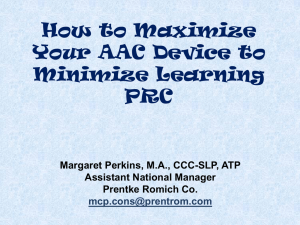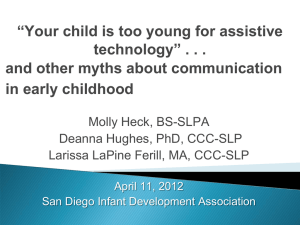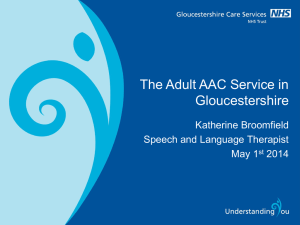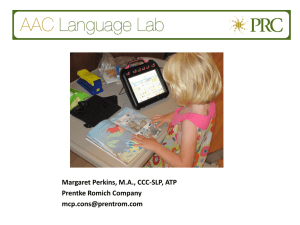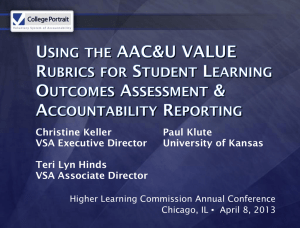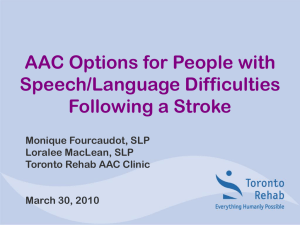SA Teachers - School of Education
advertisement
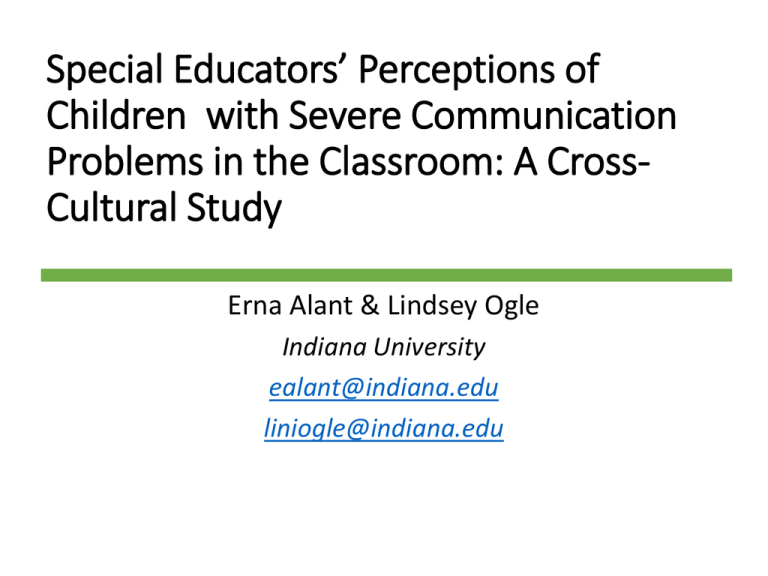
Special Educators’ Perceptions of Children with Severe Communication Problems in the Classroom: A CrossCultural Study Erna Alant & Lindsey Ogle Indiana University ealant@indiana.edu liniogle@indiana.edu Acknowledgements National Research Foundation of South Africa (NRF) MCCSC schools teachers Teachers from UNICA school for Autism in Pretoria, SA Two research assistants in Pretoria: Christine Emmett and Kogie Moodley AAC lab research group: Lindsey Ogle, Wenjing Zheng, Paulo Tan, Michael Verde & Santoshi Halder (Calcutta University, India) Overview • Rationale for the study • Methodology • • • • Participants Settings Data collection Data analysis and Confirmability of data • Findings • Conclusions Rationale • Teachers play a central role in providing quality education because of their interaction with students • Children with severe communication problems pose significant challenges • Use of augmentative and alternative strategies to facilitate communication • Various studies conducted in US: • Soto, Muller, Hunt & Goetz (2001) • Bailey, Stoner, Parette & Angell (2006) • McNaughton, Rackensberger, Benedek-Wood, Krezman, Williams & Light (2008) • Alant, Champion & Peabody (2012) Why a cross-cultural study? • Goodnow (2006) • Second look at practices and assumptions usually taken for granted • Re-examine our understanding of aspects of research • Investigate the impact of differing resources, know-how, populations, and circumstances on perceptions and outcomes • Cleary (2012) • Cross-cultural research integrity Purpose of the study To describe and compare the perceptions of teachers who work with children with severe communication problems in two contexts: • School for Children with Autism in South Africa • School district in Indiana Method • Design: Non-experimental Comparative Design using mixed methods. • Rating Scale • Individual Interviews • Participants • 10 teachers from each context, 20 participants in total • Recruitment • Demographic Characteristics American Teacher Demographics ID Age Years Exp. SPED 5 Education Special Qualifications 28 Years Teach Exp. 5 US1 BA Special Ed. Severe US2 50 24 22 BA Special Ed. none US3 35 10 10 MA Special Ed. Behavioral Analysis, Severe US4 51 19 19 MA Special Ed. Severe/Profound US5 35 10 7 MA Special Ed. Mild, Severe US6 37 1 7 BA Philosophy and Religion Special Ed. US7 37 6 2 Mild, Severe US8 62* 25 25 US9 32 10 10 MA Special Ed. in progress, BA Elem Ed MA Education Special Ed. endorsement MA Special Ed. US10 30 8 8 MA Education, BA Special Ed. Mild, Emotional Disorders Mild Orthopedic Impairment South African Teacher Demographics ID Age Years Exp. SPED 14 Education Special Qualifications 51 Years Teach Exp. 24 SA1 BA Ed Training in ASD and Min Brain SA2 61 30 22 THOD 4yr PrePrim/Prim Training in AAC and ASD SA3 50 24 15 BA Bible St and EDUC SA4 53 29 24 THOD, Dip in SPED P-G Dip in lrn dis, ABET assesor, HOD, Plan to get AAC hon Training in sev SA5 48 26 22 H Dip ED, Further Ed Dip ED SA6 53 26 26 BA, Hon PSY, Dip Rem Teach SA7 41 15 2 BA ED SA8 27 4 4 Hon in AAC, SPED teach degree SA9 45 19 7 SA10 52 14 11 2nd Teach Dip, HED, SPED in ACE prg BA in Bio and Physio, BA PSY and Lang, HED, FED in EDUC Remed Teach (2yr), Min Brain Func none Some training in Makaton, Tiny Hands none Plan to do AAC cert next yr Enrolled in AAC program, Makaton training Teacher Demographics Comparison Analysis Mean SD USA 39.70 10.955 SA 48.10 9.110 Years Experience USA 11.80 8.135 SA 21.10 8.103 Years SPED Experience USA 10.80 8.470 SA 14.70 8.629 Age t (df = 18) Sig. (2tailed) Cohen's Effectsize d r -1.864 0.079 -0.879 0.402 -2.561 0.020* -1.207 0.517* -1.020 0.321 -0.481 0.234 Years experience was the only quantitative demographic significantly different (t=-2.561, p<.05) between the two countries suggesting that the South African teachers had more experience and were older. The lack of a significant difference in age is due to an outlier in the US teachers (US8 – age 62) who was considerably older than the other teachers surveyed who when removed resulted in a significant difference between the two countries. Comparison of Demographics • US teachers taught in self-contained classrooms, while the teachers from South Africa were from the same special school for children with autism. • Although it is difficult to compare qualifications between the groups, most of the US teachers had a bachelors degree in special education while the majority of the SA teachers had general education diplomas or degrees. Most of the specialized training in special education for the SA teachers was part of in-service training through short courses or short certificates and diplomas. Settings United States Mid-western school district that includes 21 schools and serve around 120,715 students with approximately 407 school-aged students with a primary communication disability. The median household income is $36,270. US special educators had 6-8 students and 3-4 para educators, and thus a maximum ratio of educators to students of 1:2. Well-resourced school context: Very good access to AT in classes. South Africa School for children with autism in Gauteng, South Africa that serves 107 students between the ages of 3 and 18. It also has a hostel which accommodates approximately 40 children. Most students come from the province Gauteng, but students from other provinces and countries attend. These students have varying degrees of remedial problems, learning difficulties and/or intellectual disabilities. SA special educators had on average 810 students and one teaching assistant, and thus a maximum ratio of educators to students of 1:5. Well-resourced school for context: AT less available Procedures • Principle researcher is familiar with the school in South Africa and has been involved in the Indiana school district for 4 years. • All US participants were interviewed in their classroom settings. • The majority of SA participants were interviewed in their classroom settings although four were conducted through Skype at the school. The interviewer (and principle researcher) had met all the SA participants on previous visits to the school in Gauteng. • IRB approval was granted by both Indiana University in the United States and University of Pretoria in South Africa Data collection Rating scale • 20 statements about perceptions of students with severe communication problems • 6-Point Likert Rating Scale: 1 “Strongly Agree” – 6 “Strongly Disagree” Individual Interviews • Semi-structured interviews • Interviews lasted approximately 60 minutes • Majority were completed in person in the classroom, while four others were conducted via Skype. Significant Results of the Rating Scale Scale: 1 (Strongly Agree) – 6 (Strongly Disagree) Q3: They will not be able to find fulltime employment in the future Q4: Many of these children don’t really have anything to communicate Q9: The use of a communication device can inhibit the speech development of the child Q12: Using a communication device to communicate with peers is not very effective Q18: The rate with which they communicate is not an issue in participating in classroom interactions Mean SD USA 4.90 1.101 SA 3.50 1.354 USA 5.90 0.316 SA 4.60 1.265 USA 5.40 0.516 SA 3.90 1.969 USA 5.40 0.516 SA 4.20 1.317 USA 4.90 0.568 SA 3.70 1.494 t (df = 18) 2.537 Sig. (2tailed) Cohen's d Effect Size r 0.021* 1.196 0.513* 3.153 0.006** 1.487 0.596* 2.330 0.032* 1.098 0.481* 2.683 0.015* 1.265 0.534* 2.374 0.029* 1.119 0.488* Rating Scale In comparison to SA teachers, US teachers were: • More likely to believe that their students will be able to find full time work (2.537, p=0.021) • Less likely to believe that their students do not have anything to communicate (3.153, p=0.006) • More likely to believe that the rate of communication is a barrier to classroom participation (2.374, p=0.029) • Less likely to believe that the use of a speech generating device impairs speech development (2.330, p=0.032) • Less likely to believe that using a speech generating device is ineffective when communicating with peers (2.683, p=0.015) Interview Questions • Child description: Think of one child you regard as representative of the children with severe communication problems you have worked with. • Describe the behavior of this child • Describe the child’s communication • Describe specific devices • Describe the child social interaction and friends • Describe classroom activities and intervention: support and curriculum • Describe challenges experienced • Define language, speech and communication • Comments Data Analysis & Confirmability of Data • Interviews were transcribed, checked by all participants to obtain agreement that the transcripts were representative of the interviews • Analyzed using Nvivo • 26 Categories : Interrater agreement ranged between 88,43 – 100% • Categories were combined into 6 broader themes Findings Behavior US teachers: • Focused on descriptions of behavior • De-contextualized language (Hall 1971) # 1: He is aggressive and self-injurious. He has a short fuse..He spends time on the computer at home – gets to school and wants to continue.. #3: He has significant communication needs and.. he has significant behavioral concerns. If he had one of these incidences (it) required two people to hold him in here. These incidences requires two people to hold him down. He will be really disruptive and physically aggressive and say really demeaning things and he will use profanity… #4: He has self injurious behavior. He hits his head, screams and hits his face. #6: You have to be very direct and forceful with your voice “ X hands in your pockets”. If you don’t he would continue to escalate and often become violent” Behavior… SA teachers: • Tended to describe behavior in relation to themselves or the child • Context-dependent descriptions # 1: He will have a temper tantrum, but he will not throw things # 10: His tantrums are severe, he’s got severe food fads…He is very sound sensitive and he is also tactile sensitive as well as sensitive for light # 2: When he began with me this year, he was very negative- I felt there is negative behavior #6: He has crying spells, disruptive behavior and not following any demand, if you put him at his work station, ask him to do some work, he will not react…difficult, difficult behavior #8. Scratching and hurting other children – I am working on it Child Communication US Teachers: • • • • Great difficulties understanding the children Very limited interpersonal communication Limited use of devices Scripted utterances #8: I have no clue – I have a lack of understanding of the child. I get pieces of what he says #11: He communicates his needs, but there is no interpersonal communication – it is a frustration. Lack of understanding of breakdown.. #3: Unfortunately he can’t read or write. It’s hard when you have everyday conversations – he can’t. No meaningful conversation. I wish I can understand! #5: He uses eye contact to tell us what he wants. His device is seldom used. He uses his device mainly for academic skills. Conversation is not instant- it needs to be predicted to set up pages #6: He spoke well, but it is prescripted- things he repeats over and over. There was not much real communication- lead to behavior….What is the real meaning here? #9: He likes to use verbal communication first, then sign. The last thing he will use is his device. Child Communication… SA teachers: • Reliance on speech – frustrations • Descriptions of the use of body to communicate, use of touch • Comprehension problems #5: He would take you to the cupboard, look you in the eye and the same with food. He would show you with PECS, his eye and take your hand. He can make his needs known – that is all. He can’t tell you about a movie. Limited understanding. #6: He can take my hand, show me what he wants. With PECS he started to speak “plate please”…. PECS was life changing for this child. #7: I think he can communicate but on a low level due to comprehension problems. When we talk about emotions he is not able to tell me how he is feeling #8: First he communicates through body language and crying, now he uses PECS and his visual schedule.. When I am on the playground with him, he will try..sit next to me and I have to scratch his back, he will put my hand on his back and he will laugh and go away Use of AAC devices US teachers: • Overwhelmed by options and programming of devices • Doubt of the effect of the device: What does it add? • Programming messages for parents #5 Too many choices from the device can be confusing – sometimes he did better without. The time needed for creating new pages. You need 30 minutes to program the device for 20 minute interaction. You end up using the device for programming for time than the student gets to use it at school #6 In the beginning she was very restless. I don’t know that her behavior has change more with her device #3 Lots of goals we work on here is not followed through on at home. Everybody is always thinking pictures, but it is impossible – you can’t put every word there #10 we are looking for more technology with him. What will it add? Just to be able to get his wants and needs across – things like that. We are considering the iPad - actually it was the parents who wanted it #2 He used a Mighty Mo – he liked it but couldn’t participate on the spot. It was good for home-school communication. We programmed messages for the parents…It seemed a little staged. Communication is not interactive – it didn’t make it typical, but make it makes it possible to participate Use of AAC devices… SA teachers: • Very few devices, mostly digitized speakers • Use of PECS #2. The kind of device where he pushes the right button and produce the right answer. We don’t have it on a full time basis. The speech therapist would like to support us but mainly it’s a device where there is sound and pre-programmed language – GoTalk. #3. We use the cellphone to get him to identify himself Classroom Intervention/ Curriculum US Teachers: • Structured program: 10 minutes, not very flexible due to adult personnel • Try to reduce requirements for communication • Making schedules for child and adults take time #3 We use a very structured program – 10 minutes. You can not have students not know what to do and the adults not knowing where they are… He doesn’t know the first letters of his name and last name as a second grader but then we really need to focus on speech and getting that up #11 The best type of activities are those that do not require communication. Difficult to know how to break up concepts so that they can participate #7 When he came from preschool I was told he will not work, he cannot sit still. Now he can sit for 20 minutes. He is set in routines. He also assists in passing out books. #5 making schedules takes a lot of time…time for preparation as well as addressing the students’ needs. Then after, it is the adult schedules for para-educators. #1. ..The first year I created an autism utopia but then when we went to lunch it was difficult. We can’t have the same structure in arts as in the class. Those create barriers for us “but that is the world!”. One needs to educate the child in the school not just in the class! Classroom Intervention… SA Teachers: • Twice a week personal facilitator– focus on academics • Lined up activities, but often don’t do these • 9 children with behavior problems – challenges #1 . He has a facilitator that comes in twice a week – then they work one on one – then he will do academic work….We try to get him to communicate to us or tell him what he has experienced. Everybody gets a turn…we communicate all day long, so communication is basically the main thing #6 we have specific activities lined up- that they do these, but not as I lined them up, but we are going to get there. We have snack time form 9:30-10 because you have to teach them how to eat properly. #7.I try to do language through math – how to communicate their needs, what they are thinking – #8. I have 9 children with behavior problems- just keep them quiet – give him a clock to time how long he needs to be quiet before break. Parent Interactions US Teachers: • Parents too powerful, teachers taken out of it • Lack of communication with families • Acknowledgement and appreciation for the role of the family #8. The parents are running the show and we kind of lost our way…the teacher has been taken out of it because so many law suits.. #3. I would definitely have to say that one of the biggest problems is the lack of communication the family has given me #5. Great expectations coming from parents… he should achieve more academically. #10. It is great. They (parents) will send a DVD to explain their child to new teachers. I know it is difficult for the parents because of the communication. They don’t know what is going on with the students. #11. Nobody knows the kid better than the parent so if I have trouble with something with the child, I usually ask the parent right away. Usually the parents can tell you. On the rare occasions that they can’t then we try and figure it out together. #1. …Lot of goals that we work on here is not followed through at home. So you know, there is only so much you can do….(Use of device):…we would go to a quiet area to program for the parents what happened during the day – communicate with the parent by recording messages on the device that he could communicate to them. Parent Interactions… SA Teachers: • Empathy for parents – preference for face-to-face meetings • Trust building • Frequent contact – phone calls #1. I have a lot of empathy for the parents, especially those parents, they don’t really know where they are going with him…I don’t like to write letters, I’d rather have them eye-to-eye in meetings or I’ve got lots of telephone conversations. #7 Well, I'm new now so parents are a bit unsure, so we’re trying to gain trust as well on both sides. And I’m doing the best I can, I explain to them and I have an open door policy where they can come in and tell me their frustrations and what they’re going through at home with the kids so that we can work together and try to address some of these things. #1 I had lots of phone calls and letters from the parents because my ways were not the same as the previous teachers’ ways” Social Interactions US Teachers : • Each child’s IEP includes social goals • Children like him, but no friendships #8. The kids like him, but..it’s not really a friend and I don’t really know where they live, they probably keep him in the apartment a lot. #11...they will look out for him. But he doesn’t have friends in that the student will sit down and strike up a conversation . So it is a strange thing… #6 socialize? Much more interactive with adults than peers. There are lots of student show like him and gave him attention, not sure in his mind that it meant much Social Interactions SA Teachers: • Physical inclusion, but not social integration • Focus on weekly community outings and integration #1..there is another boy in my class who desperately wanted to visit his house, so the parents arranged it. But in the end, this kid was in his room in front of his computer and the other one was in front of the TV in the lounge. So they don’t mingle at all. #10. I force him to sit in group situations…Ya, but I mean he likes to be on his own, but it’s not good for him #3 He’ll have one or two (friends), but you can’t say it is his friends. He’s happy with his own company most of the time. So he is typical in that he will go an sit and he’s not bothered, due to the fact that there is no communication. Teachers’ Comments US Teachers: • Dedication and Commitment of teachers • Awareness of fairness in accommodating the children with special needs #8. You know, we are the ones that have the problem. He knows what he is saying. And he’s making perfect sense and he is, once you find out! #11. If you have a teacher that feels like any child regardless of what they have, will be too much for them, then it is the wrong classroom for that child…that kid can not be seen as something that is drawing you away from the other kids, but something to make your instruction better for the entire group. You are going to change your teaching style in such a way that you are going to incorporate new ideas that will make your instruction better. #4. I love my job – I wouldn’t do anything else Teachers’ Comments… SA Teachers: • • • • Disability Right Awareness, value of individuals Flexibility and learning Love for the children Personal growth as a teacher #3: It’s not a disease, the fact that X cannot speak is nobody’s fault. It’s a gift, I think it’s a gift if you cannot speak. Because how X can get so far without language, it’s not the alpha and omega to me. But I have seen a boy in my class who’s got the courage to fight for what he wants without saying a word. …It’s my approach to totally win them over to be better citizens. These kids taught me to open myself to change as a person. They did me the favor of my life. #7 for me there is no set recipe. Every day I’s learning – and you learn things about yourself and the kids. It’s challenging, it’s hard but its also very very rewarding #9. It you don’t have love, it won’t be easy for anyone to be doing what we are doing here. That’s all I can say. #2, ..I mean when you are 59 you know your strong abilities and your weak abilities, so I’m not academically strong, but I try to have first a strong relationship with my children and definitely with their parents. Because we are a team and if they don’t feel at ease with you, how will they send their only or their beloved child with you? Interpretation: General • Balancing task-orientation and relationship building in the classroom: instrumental vs relational • Professional behavior, de-contextualized language • Being with the children in interaction: contextual language • Difficulties in finding a balance: pressures and task-orientation vs building relationships/ getting to know the children. • Teacher identify • Personal involvement, professional identity • Specialized knowledge does not guarantee the ability to communicate with children with severe communication problems Interpretation: class context • Structural difficulties: • Number of adults in the class can limited interactions between teacher and children – impacting their relationship • Time spent scheduling versus time spent interacting with children AAC • Need to ensure teachers and parents understand what communication is about: development of meaning • Need to assist teachers in facilitating their understanding of these children • Problem-solve better solutions to device implementation in the schools: more sophisticated devices do not necessarily equal better communication • Specialized knowledge does not guarantee the ability to communicate with children with severe communication problems References • Alant, E; Champion, A & Peabody, E. (2013). Alant, E; Champion, A & Peabody, E . 2012 Exploring Interagency collaboration in AAC Intervention. Communication Disorders Quarterly, November. http://cdq.sagepub.com/content/early/recent • Alant, E; Uys, K & Tonsing, K. (2009). Communication, language and literacy learning in children with developmental disabilities. In Matson, J; Andrasik, F; Matson, M (Eds). Treating childhood psychopathology and developmental disabilities, 373-402. • Cleary, L. (2013). Cross-cultural research with integrity. New York: Palgrave Macmillan. • Fang, Z (1996). A review of research on teacher beliefs and practices. Educational Research, 38, 47-65. • Gentner, D; Namy, L (2006). Analogical processes in language learning. Current Directions in Psychological Science, 15, 6, 297-301. • Keen, D; Woodyatt, G & Sigafoos, J. (2002). Verifying teacher perceptions of the potential communicative acts of children with autism, Communication Disorders Quarterly, 23, 3, 131140. • Rita, L.; Stoner, J.; Parette, H. Jr & Angell, M. (2006). AAC Team perceptions: Augmentative and Alternative Communication Device Use. Education and Training in Developmental disabilities, 41(2), 139-154. • Soto, G.; Muller, E; Hunt, P. & Goetz, L. (2001). Professional skills for serving students who use AAC in general education classrooms: A team perspective. Language, Speech and Hearing Services in Schools, 3, 51-56. Thank you For a copy of this presentation, please go to the following website: www.education.indiana.edu/aac


